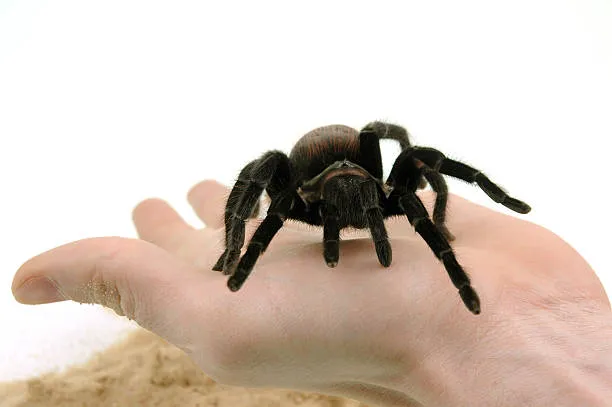What is a Tarantula Holding Experience?
A tarantula holding experience offers a unique opportunity to interact with these fascinating creatures, moving beyond observation to direct, hands-on engagement. Typically, these experiences are guided by trained professionals who provide education, safety instructions, and the chance to hold a tarantula. The primary goal is to provide a memorable and educational experience that dispels common fears and misconceptions about spiders. Such experiences can range from brief encounters at educational events to more structured sessions at specialized facilities, giving participants a close-up look at the spider’s anatomy, behavior, and care requirements. This hands-on approach can be incredibly rewarding, fostering a greater appreciation for these often-misunderstood animals and offering a unique perspective on the natural world. It’s a chance to challenge one’s comfort zone and develop a deeper understanding of arachnids.
Benefits of Holding a Tarantula
The benefits of holding a tarantula extend beyond mere novelty. For many, it’s an exercise in overcoming arachnophobia, providing a safe environment to confront and conquer fear. This can be a significant personal achievement, boosting confidence and reducing anxiety in other areas of life. Additionally, the experience offers educational opportunities, allowing participants to learn about tarantula behavior, habitats, and the crucial role they play in ecosystems. These encounters often promote empathy and respect for wildlife. Moreover, interacting directly with a tarantula can instill a sense of wonder and appreciation for biodiversity. Many participants report a newfound respect for spiders, seeing them not as threats but as complex and intriguing animals. These experiences contribute to a more informed and positive perspective on these misunderstood creatures.
Understanding Tarantula Behavior

Understanding tarantula behavior is crucial for a safe and positive handling experience. Tarantulas are generally not aggressive, but they may react defensively if they feel threatened. Defensive behaviors include raising their front legs, showing fangs, or flicking urticating hairs, which can cause skin irritation. Handling should always be done with calm and gentle movements to avoid startling the tarantula. Tarantulas communicate through subtle body language, so observing their posture and movements can indicate their mood. For example, a tarantula that is alert and relaxed will typically have its legs spread evenly, whereas a tarantula that is stressed may hunch down or move erratically. It is important to remember that tarantulas are solitary animals, and they may not enjoy being handled. Respecting their personal space and understanding their natural behaviors are essential for a positive experience.
What to Expect During a Holding Experience
During a tarantula holding experience, participants can anticipate a structured and educational session guided by experienced handlers. The session typically begins with an introduction covering tarantula facts, including their origin, diet, and natural habitats. Safety instructions are paramount, emphasizing how to handle the tarantula gently and avoid any actions that could cause stress or injury. Participants might be given the opportunity to observe the tarantula closely before touching it. The handler usually provides step-by-step guidance, offering tips on how to hold the tarantula safely and comfortably. Some experiences may include time for questions and answers, allowing participants to delve deeper into topics of interest. Most importantly, these experiences are designed to be stress-free for both the participant and the tarantula. The goal is to replace fear with fascination and build a better understanding of these amazing creatures. Be prepared for a moment of awe, as the tarantula slowly walks on your hand.
Step-by-Step Guide to Holding a Tarantula
The step-by-step process of holding a tarantula typically begins with the handler providing clear instructions and safety precautions. First, the handler will demonstrate the proper technique, using slow and deliberate movements. Then, the participant is guided to gently place their open hand near the tarantula. The handler will then gently coax the tarantula onto the participant’s hand. The tarantula may initially be hesitant, so patience is key. Once the tarantula is on the hand, the participant should remain still, avoiding sudden movements that could startle the spider. The handler will monitor the tarantula’s behavior throughout the experience, providing guidance and reassurance. They will be present to ensure the spider’s well-being. After a brief period, the handler will gently guide the tarantula back to its enclosure. The emphasis is always on safety, respect, and a positive interaction for both the participant and the tarantula.
Preparing for the Experience

Preparing for a tarantula holding experience involves both mental and practical considerations. First, address any fears or anxieties by researching tarantulas and understanding their behavior. It may also be helpful to visualize the experience and focus on the positive aspects, such as learning and overcoming fears. Practically, it’s advisable to wear clothing that allows easy movement and does not have loose or dangling elements that could startle the tarantula. Follow all instructions given by the handler carefully, and be mindful of your actions to ensure the safety of both yourself and the tarantula. It is important to approach the experience with a sense of curiosity and respect for the animal. You can also ask questions before the encounter starts. Preparing beforehand can significantly enhance the experience. Taking these steps will help make the experience more enjoyable and less stressful.
The Holding Process
The actual holding process is a delicate and guided interaction, starting with the participant extending a calm hand near the tarantula. The handler gently encourages the tarantula to step onto the hand, often by softly nudging it with a brush or a small tool. It’s vital to remain still and avoid making any sudden movements that could startle the tarantula. The handler will monitor the tarantula’s body language closely, providing real-time guidance and reassurance. The experience is usually brief, lasting only a few minutes, to minimize stress on the animal. The handler facilitates this process, offering support and answering questions throughout the experience. The focus is always on the well-being of the tarantula and the comfort of the participant. The handler will then gently guide the tarantula back to its enclosure, ensuring a safe and positive end to the experience. Remember to breathe and try to enjoy this unique moment!
After the Holding Experience
After a tarantula holding experience, participants often experience a mix of emotions, from excitement to relief. It is important to take a moment to reflect on the experience. Many people find that their preconceived notions about tarantulas have changed, replacing fear with curiosity and respect. It is a great opportunity to engage with the handler to discuss the tarantula’s behavior and ask any remaining questions. Take pictures if permitted, and share your experience to inspire others to challenge their fears. Participants often report feeling more confident and having a greater appreciation for wildlife. After the experience, it’s also a good idea to wash your hands thoroughly with soap and water. The most important thing is to take away the positive learning experience and carry that feeling with you. The experience is a good reminder to face your fears and embrace new challenges!
Safety Precautions

Safety is paramount during a tarantula holding experience. Participants should always follow the handler’s instructions, which will emphasize the importance of slow, controlled movements and avoiding sudden actions that could startle the tarantula. Before touching a tarantula, it is important to ensure that the handler has properly assessed the spider’s temperament. Avoid wearing loose clothing or jewelry that could catch on the tarantula’s legs or body, causing injury. Always wash your hands thoroughly before and after the experience to prevent the spread of germs. It’s also crucial to be aware of potential allergic reactions or skin irritations. Respect the spider and its space, and remember that a tarantula bite, while not usually fatal to humans, can be painful. Never try to force the tarantula to do anything; be patient and understanding of the tarantula’s reactions.
Health Considerations
While tarantula bites are rare during a holding experience, understanding the potential health considerations is important. Tarantulas possess fangs and can deliver a bite if they feel threatened. The venom is generally not life-threatening to humans, but it can cause localized pain, swelling, and itching. In some individuals, allergic reactions may occur. It’s essential to be aware of your own health history and any potential allergies before participating in a handling experience. If you are bitten, seek medical attention if symptoms are severe or prolonged. After the experience, it is advisable to wash your hands thoroughly. Ensure you have no open cuts or wounds on your hands before handling the tarantula. By taking these precautions, you can minimize any risks and enjoy a safe and educational experience.
Common Tarantula Species Handled
Several tarantula species are commonly used in handling experiences due to their relatively docile temperaments and impressive appearances. The Chilean Rose Hair Tarantula is a popular choice, known for its gentle nature and beautiful coloration. The Mexican Red Knee Tarantula, with its striking red and black markings, is another favorite. The Pinktoe Tarantula, with its vibrant colors, is sometimes featured. These species are selected because they are generally less prone to defensive behaviors like biting or kicking urticating hairs. Handlers will choose a tarantula that is known to be calm and used to handling. The chosen species’ behavior is carefully observed before and during the handling experience to ensure the safety and comfort of both the participant and the spider. These species provide a great introduction to the fascinating world of tarantulas.
Where to Find a Tarantula Holding Experience

Tarantula holding experiences can be found in a variety of locations, ranging from educational institutions to specialized facilities. Zoos and aquariums are often a good starting point, as they frequently host special events or offer behind-the-scenes tours that include opportunities for hands-on interactions. Reptile expos and pet shows are also great places to find these unique experiences, with vendors and breeders often offering demonstrations or handling sessions. Search online, using keywords such as “tarantula holding experience” or “spider handling near me.” Check reviews and verify the credentials of the facility or handler to ensure safety and ethical practices. Consider any organizations dedicated to animal education. By researching and exploring these options, you can find a reputable experience that allows you to interact with these amazing creatures in a safe and educational environment.
